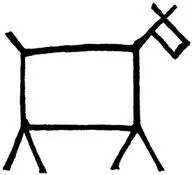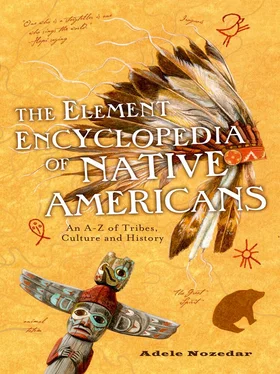In 1863, the U.S. Army perpetrated a shameful crime. Pretending to fly the flag of truce, General Joseph Rodman, under the orders of Carleton, captured Mangas Coloradas and, sometime later, murdered him. For Cochise—for anyone—what the Army had done—murdering someone under the pretence of inviting them to negotiate—utterly violated all the rules of war. And so the bloody battles continued.
Cochise and his men were driven toward the Dragoon Mountains, which provided good cover to use as a base from which the Indians could continue their attacks. For four years, Cochise managed to avoid capture by his enemies. Eventually, though, Cochise negotiated a peace treaty and retired, with his people, to a new reservation, a position which he had resisted for as long as he was able. Cochise felt that there was no need for the Native peoples to live on reservations, and that it was possible for them to live side by side in harmony with their white neighbors. He said:
“Let my people mingle with the whites, in their farms and communities, and let us be as one people.”
Sadly, this would not come to pass during Cochise’s lifetime. He died in 1874 of natural causes, and was buried in the Dragoon Mountains, in a secret location in a larger area that is now called Cochise’s Stronghold.

A Native American people belonging to the Plains Indians group, for whom the horsewas an inherent part of life and culture. The Comanche were considered among the finest horsemen of all the Indian Nations. A warlike people, largely open to new ideas, the Comanche were also buffalohunters, and had a formidable reputation for stealing cattle and horses from other tribes, a trait that would cause many fights with other Native Americans. The Comanche allegedly were responsible for killing more white men than any other tribe. They were also slave traders.
The traditional territory of the Comanches was known as the Comancheria and encompassed the lands that we now know as eastern New Mexico, southern Colorado, northeastern Arizona, southern Kansas and Oklahoma, and the majority of northwest Texas.
The Comanche are believed to have been an offshoot of the Shoshone, who broke away around 1700, when the Dakota Siouxpushed the Shoshone back into the mountains; the offshoot Comanche were driven toward the south. The horses that were to prove such an essential part of their lives were acquired from the Puebloafter their successful resistance to the Spanish, which resulted in the Spanish leaving their horses behind in Pueblo territory. Indeed, it was the Comanche who supplied horses to traders from both France and America, and also to the hopeful gold prospectors who traveled through Comanche territory on their way to California. The tribe also had access to the thousands of feral horses that ranged through their territory.
The Shoshone, Comanche, and Kiowatribes were all also known as “Snakes” by explorers such as George Catlin. The Comanches themselves were subdivided into many different “bands,” of approximately 100 members each. These bands were part of larger divisions, of which there had been three prior to 1750: the Jupes, the Kotsotakas, and the Yamparikas. In the decade after 1750 many of the Kotsotakas split away from the others and moved to the southeast, a move that caused friction between them and the original Comanches.
The Comanche did not have one single chief who controlled the whole tribe; instead, they had a number of leaders who counseled the group according to its needs at any one time. For example, different styles of leadership would be necessary during times of peace than were appropriate during war.
War was a way of life for the Comanche, and the longest battle they waged was that against the Mexicans. This particular fight ran on for nearly 40 years. Traditionally, the Comanche would lead their raids into Mexican territories at the time of the full moon, so that they had the element of surprise combined with the visibility that the full moon gave them. This strategy gave rise to the term “Comanche Moon.”
Initially the Comanche were hunter-gatherers; women as well as men would hunt. Subsequently, though, when the tribes moved from the Rocky Mountains to the Plains, huntingbecame the job of the men. Deer, wild mustang, bear, elk, and buffalo were all captured and eaten; the fur, bones, and teeth were all made good use of. The Comanche were also not averse to raiding Texas in search of cattle. The Comanche would eat birds and fish only when there was nothing else. This meaty diet was supplemented by berries, fruits, and nuts; gathering these was the task of the women. The Comanche did not cultivate the staple crops of the Native Americans, such as corn, maize, and tobacco, but instead acquired them through trading or raiding.
When they wanted to cook meat or vegetables the Comanche women would dig a hole, which they then lined with skins or the stomach of a buffalo to make it waterproof. Hot stones made the water boil, and enabled the food to be cooked. The metal pots of the Spanish and other European settlers would make this domestic task much easier. A delicacy for the Comanche hunters was the curdled milk from the stomachs of buffalo calves that were still suckling.
In common with other Plains Indians, the Comanche were very hospitable, and prepared something to eat whenever a visitor arrived. This meant that people not used to such a custom took it as read that the Comanche ate at all hours of day or night.
Like other Plains Indians, the Comanche lived in tipis, the portable home made of skins draped around a cone-shaped construction of loose poles. Their clothing was simple: for the men, a breechcloth, deerskin leggings, and moccasins; in winter the upper torso was covered in buffalo-hide robes. Small boys went naked except in very cold weather. Women traditionally wore deerskin dresses, with beautiful fringing along the hems and sleeves. These dresses were often beaded, or had metalwork inserts that were similar to the mirrorworkdone in India, in which small pieces of mirror are stitched into the pattern of the fabric. The women also wore moccasins and buffalo-hide robes. Young girls, unlike their brothers, did wear clothes: breechcloths from the time they were babies until they were old enough to wear smaller replicas of the clothes worn by the women.
Comanche men were proud of their earrings; the womenfolk pierced the men’s ears with as many as eight holes, which would be ornamented with shells or loops of wire. The men also had facial tattoos as well as markings on their chests and arms. These took the form of geometric designs; both design and color were the choice of the individual, although black was universally used in the case of war paint. Comanche women liked to paint the very insides of their ears a brilliant red.
When a Comanche died, the corpse was wrapped in a blanket and placed on a horse, with a rider. The rider would then carry the body until he found a place that was right for the burial of the body. The burial place was marked by stones and boulders, then the rider returned, his task completed. The possessions that had belonged to the dead person were burned, and the mourning began. As in other tribes, the chief mourner would slash his or her arms as a demonstration of grief. The Christian missionaries, however, persuaded the Comanche that the “proper” way to respect their dead was to bury them in wooden coffins in the ground.
Читать дальше













